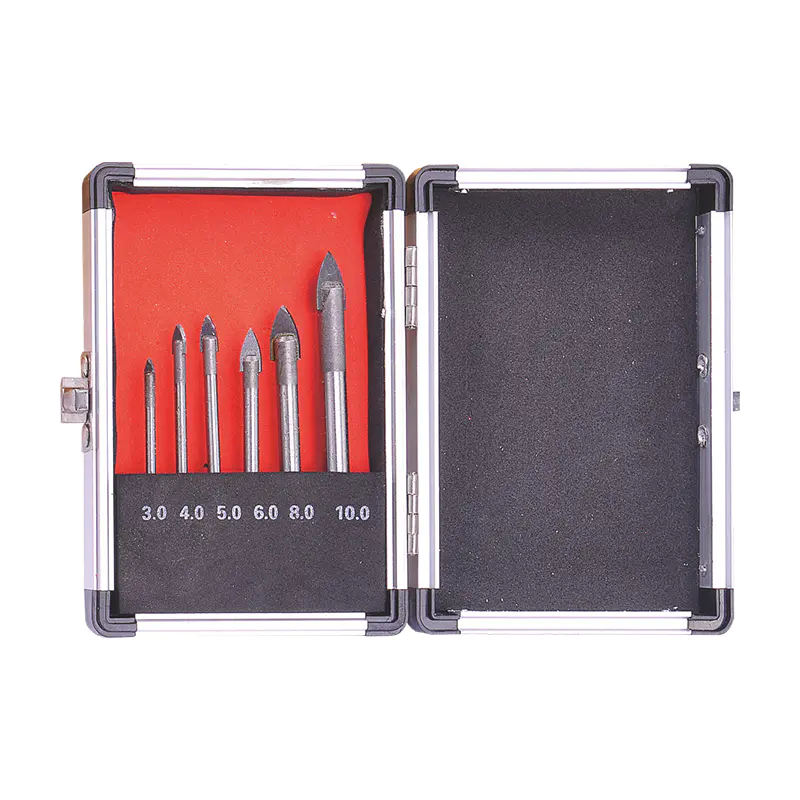2025-10-24
Unlike metals or wood, glass is brittle, prone to cracking, and requires precision combined with specialized tools to achieve clean and accurate holes. A Glass Drill Bit is designed specifically for this purpose, offering a combination of strength and precision that standard drill bits cannot provide. Evaluating the cutting efficiency of such a bit on glass involves considering not only the speed of drilling but also the quality of the resulting hole, the risk of damage, and the durability of the tool itself.

The cutting efficiency of a drill bit on glass is influenced by several important factors. The material composition of the bit plays a significant role, with diamond-tipped or carbide-coated designs generally providing high performance. The geometry of the bit is also crucial, as a spear-point or hollow-core shape can help reduce stress concentration on the fragile glass surface. Additionally, drilling speed and pressure determine how effectively the bit engages with the material. Excessive speed or force often causes fractures, while controlled low-speed operation improves efficiency without compromising safety.
One of the essential requirements for drilling glass efficiently is the use of proper cooling and lubrication. Water is commonly applied to the drilling area to prevent excessive heat buildup, which can weaken the glass and cause cracking. The presence of coolant not only extends the lifespan of the bit but also helps maintain consistent cutting action. Without adequate cooling, even the advanced drill bits lose efficiency quickly, as heat dulls the cutting edge and increases resistance during the drilling process.
Not all glass surfaces present the same level of difficulty. Standard window glass is generally easier to drill than tempered or laminated glass, which are specifically engineered for strength and safety. A Glass Drill Bit performs efficiently on ordinary glass, creating smooth edges and accurate holes when used under proper conditions. On tempered glass, however, efficiency decreases sharply, as this material is designed to resist fracture and can shatter when drilled. Laminated glass adds another layer of complexity, where efficiency depends on how well the bit can penetrate both the glass layers and the inner polymer sheet.
While the bit itself is a key factor, the operator’s technique significantly affects efficiency as well. Proper positioning of the drill, steady application of pressure, and maintaining alignment are all critical. Drilling should usually begin at a low angle before transitioning to vertical penetration, reducing the likelihood of surface cracks. Skilled operators achieve much higher cutting efficiency, as they can balance speed, pressure, and cooling in a way that reduces material damage. Inexperienced users may find that efficiency drops due to excessive pressure or failure to maintain lubrication.
Cutting efficiency should not be measured solely by how quickly a hole is created. In glass drilling, efficiency also includes reducing breakage, ensuring a smooth edge, and reducing tool wear. A process that takes slightly longer but results in a clean, undamaged hole is ultimately more efficient than one that is fast but causes cracks or destroys the bit prematurely. Thus, evaluating efficiency must consider overall results rather than focusing exclusively on drilling time.
The cutting efficiency of a Glass Drill Bit on glass is determined by a combination of tool design, operating conditions, cooling methods, and operator skill. When these factors are optimized, the bit can achieve good results, producing precise and clean holes without damaging the material. While challenges remain with advanced types of glass, such as tempered and laminated varieties, proper technique and the right equipment significantly improve outcomes. In this context, efficiency should be defined not only by drilling speed but also by quality, safety, and tool longevity, ensuring that the drilling process is both effective and reliable.